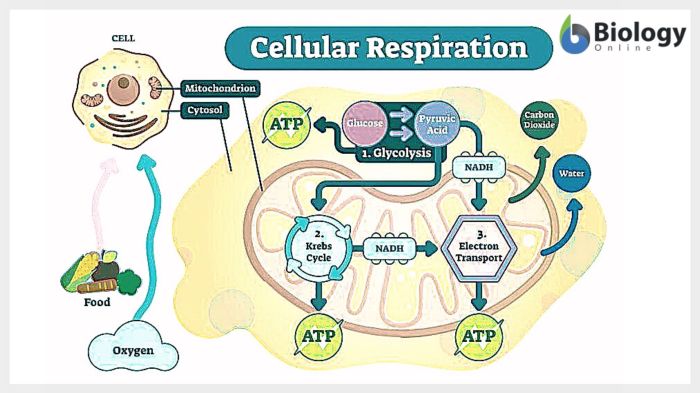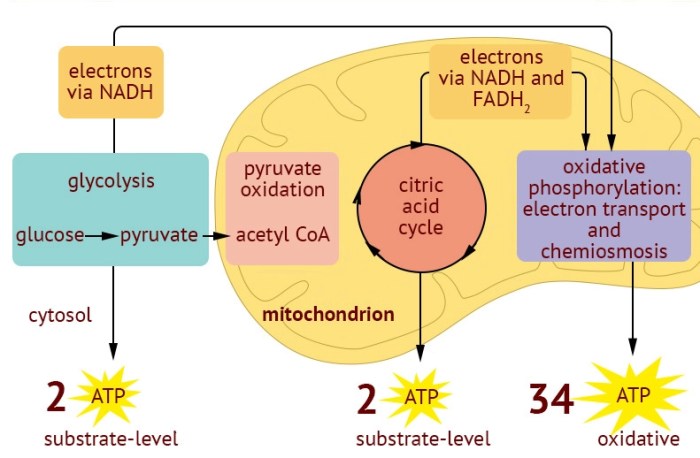Match each stage of cellular respiration with its description. Cellular respiration is a series of metabolic reactions that take place in the cells of organisms to convert biochemical energy from nutrients into adenosine triphosphate (ATP), and then release waste products.
This process is essential for the survival of all living organisms because ATP serves as the main energy currency for cells.
Cellular respiration occurs in three main stages: glycolysis, the Krebs cycle (citric acid cycle), and oxidative phosphorylation. Each stage has a unique set of reactions and functions, and together they contribute to the overall energy production process.
Cellular Respiration

Cellular respiration is a set of metabolic reactions that take place in the cells of organisms to convert biochemical energy from nutrients into adenosine triphosphate (ATP), and then release waste products. This process is essential for the survival of all living organisms because ATP serves as the main energy currency for cells.
1. Glycolysis
Glycolysis is the first stage of cellular respiration. It occurs in the cytoplasm of the cell and involves the breakdown of glucose, a six-carbon sugar, into two molecules of pyruvate, a three-carbon compound.
| Reactants | Products |
|---|---|
| Glucose | 2 Pyruvate |
| 2 ATP | 4 ATP |
| 2 NAD+ | 2 NADH |
The energy yield of glycolysis is 2 net ATP molecules.
2. Pyruvate Oxidation
Pyruvate oxidation is the second stage of cellular respiration. It occurs in the mitochondrial matrix and involves the conversion of pyruvate into acetyl-CoA, a two-carbon compound.
NADH and FADH2 are electron carriers that are produced during pyruvate oxidation. These carriers will later be used in oxidative phosphorylation to generate ATP.
The energy yield of pyruvate oxidation is 2 NADH and 2 FADH2 molecules.
3. Citric Acid Cycle (Krebs Cycle), Match each stage of cellular respiration with its description.
The citric acid cycle is the third stage of cellular respiration. It occurs in the mitochondrial matrix and involves the oxidation of acetyl-CoA to produce carbon dioxide and energy-rich molecules.
| Reactants | Products |
|---|---|
| Acetyl-CoA | 2 CO2 |
| 3 NAD+ | 3 NADH |
| 1 FAD | 1 FADH2 |
| 1 GDP | 1 GTP |
The energy yield of the citric acid cycle is 3 NADH, 1 FADH2, and 1 GTP molecules.
4. Oxidative Phosphorylation
Oxidative phosphorylation is the fourth and final stage of cellular respiration. It occurs in the inner mitochondrial membrane and involves the transfer of electrons from NADH and FADH2 to oxygen.
The electron transport chain is a series of protein complexes that facilitate the transfer of electrons. As electrons pass through the chain, they lose energy, which is used to pump protons across the inner mitochondrial membrane.
The proton gradient created by the electron transport chain is used to drive the synthesis of ATP by ATP synthase.
The energy yield of oxidative phosphorylation is 28-32 ATP molecules.
FAQ Insights: Match Each Stage Of Cellular Respiration With Its Description.
What is the role of glycolysis in cellular respiration?
Glycolysis is the first stage of cellular respiration and occurs in the cytoplasm of the cell. It breaks down glucose, a six-carbon sugar molecule, into two three-carbon molecules called pyruvate. This process also generates a small amount of ATP and NADH, an electron carrier.
What happens in the Krebs cycle?
The Krebs cycle, also known as the citric acid cycle, is the second stage of cellular respiration and takes place in the mitochondria of the cell. It further breaks down pyruvate into carbon dioxide and generates ATP, NADH, and FADH2, another electron carrier.
How does oxidative phosphorylation produce ATP?
Oxidative phosphorylation is the final stage of cellular respiration and occurs in the inner membrane of the mitochondria. It uses the electron carriers NADH and FADH2 to generate a proton gradient across the membrane, which drives the synthesis of ATP.


